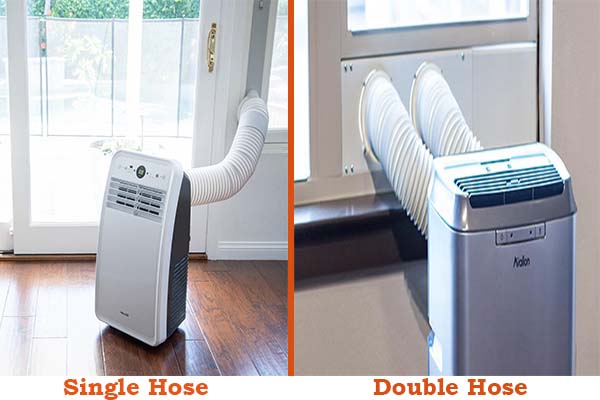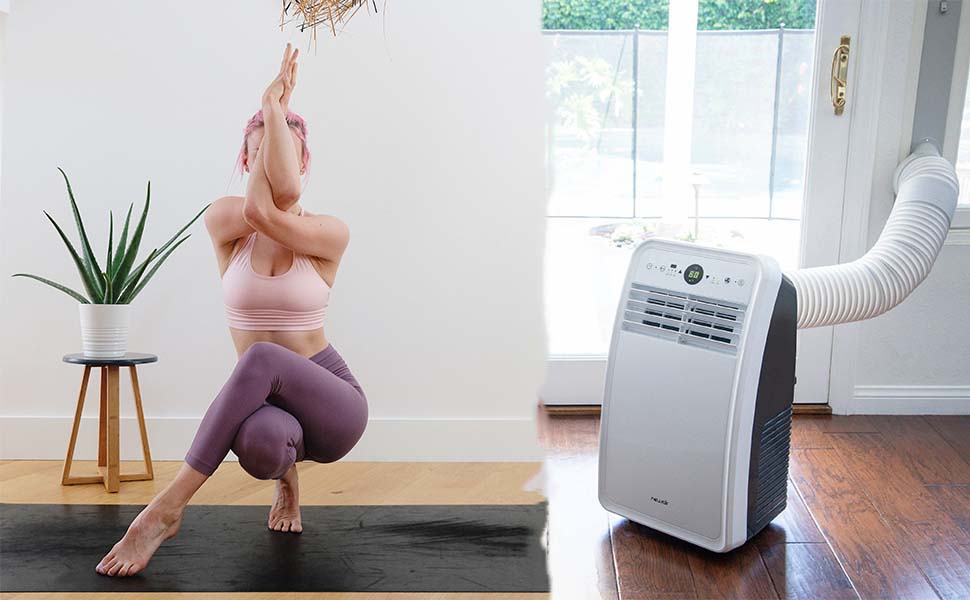Last Updated on January 11, 2023 by TechChecking
Extremely and unbearable hot! Well, a portable air conditioner would be the best solution for a small room. And if you do have not a central AC yet, a personal air conditioner fan would be the best alternative option to cool your room. If you are intending to purchase a portable AC unit, you just need to know the most common FAQs about portable air conditioners.
Now if you have already made up your mind to purchase a portable air conditioner, there may be a lot of random questions wandering in your mind. It should be because you are going to buy this portable AC unit for the first time and it is natural to have a lot of questions to ask.
Yes, among many questions, we have selected the most important and the 9 most common FAQs About Portable Air Conditioners for you to resolve your curiosity. We hope you will get all your questions’ answers in our FAQ discussion.
Contents
Most Common FAQs About Portable Air Conditioners
1. What is a portable air conditioner?
A portable air conditioner is a mobile compact device. It is unlike a window AC that needs to go through walls. You can install it right away and no deep mechanics wisdom is needed. These portable air conditioners are lightweight and have caster wheels to move from place to place easily. Above all they tend to generally be tall about 28″ to 34″. For a single room, a portable AC unit would be perfect. They are comparatively cheaper as well.
2. Do all portable air conditioners need to vent?
The most frequent question a seller has to face is whether all portable air conditioners need to vent or not. Well, the answer is yes. They are like any air conditioning system so all the portable air conditioners need to be vented in some form or fashion. If you know how a portable air conditioner works, you must understand whether a portable air conditioner needs to vent or not.
Do you know why portable ACs need to vent out? Well, a portable air conditioner pulls in warm air, cools it, and then releases it out of the front of the unit. And the remaining hot air and moisture are vented out of the back of the unit as well. It is the warm air and moisture that is required to vent out of the room you are currently cooling.
This is why the most popular and easiest way to vent out your portable ac unit is through a nearby window. And that’s why every portable air conditioner the seller offers on-site includes an easy-to-use window snap kit.
3. What is required to set up a portable AC?
This question has no direct answers because the requirements vary based on the models. The good news is most models of portable AC found in the market are incredibly easy, quick, harassment-free, and painless to set up. Even an inexperienced person can set up it by seeing the manual book.
However, we all know that all portable ACs release warm air and moisture, and the air needs to be released to another location which is generally outside through an included window kit. The window kits have a window slider and exhaust hose (in terms of single hose) or hoses (in terms of double hoses) in order to set up easily to exhaust hot air outside.
Moreover, some models require to be vented into a drop ceiling or through a wall which most people show reluctance. Well, once you set up the exhaust hose and window kit, everything is now ready to go. You can now simply plug in your portable AC unit and it is a go. Enjoy a cooling atmosphere in your room.
To sum up, to set up a portable AC unit, the following requirements are necessary:
- A window or other opening to the outside for the exhaust hose to connect to
- Free space next to the window or opening for the unit to be positioned
- A 115/120-volt power outlet. The special case here is compact AC units that use 14,000 BTUs or more. These air conditioners may need to be on their own circuit with a distinctively measured outlet.
If anything requires more for your particular brand and model must be provided or will be suggested in the portable air conditioner owner’s manual.
4. How noisy is a portable air conditioner?
One of the discernible questions is how noisy would a portable air conditioner be? Yes, it is, of course, a matter of concern. Some models roar like lions while some let you sleep quietly. Instead of getting an answer of Yes/No, if you do understand the process that will help you better.
Well, when a device uses both a compressor and fan, it makes sounds. The compressor and fan are used to release the hot air out of the room and to make the room cool. To do this process, the compressor needs to work inside and so does the fan. In this case, a portable air conditioner unit uses both a compressor and fan.
So, that being said, you better need to pay attention to the Decibel Rating (dB level). You can easily find it on each product’s description page.
To give you an idea, two examples are shown below:
- 48 dB – in this range, it makes the noise level as falling rain
- 60 dB – in this range, it makes the noise as a normal conversation
Anyway, most units fall between these two ranges. Without this normal sound, how can a portable cooler work? But yes, some expensive and renowned company tries to provide better portable AC with lower noise. We suggest, try to pick the best one.
5. Do I Have to Drain Water from a Portable Air Conditioner?
A very wise question to ask first-time users. Well, there are some models of portable air conditioners that you need to drain water.
The straight-cut answer to this question is Yes, you have to remove water from a portable AC from time to time. But the good news is there are some easy methods for how to do it.
If you have already learned that one of the main jobs of a portable air conditioner is to take moisture out of the air in order to make the room less humid.
There are three most popular ways to deal with this condensate water. They are:
Fully Self-Evaporative Models – the advanced portable ACs automatically evaporate moisture out the exhaust hose along with warm air. This means you may hardly have to deal with the collected water. These models are highly popular amongst users due to their lower maintenance. You can choose such a model from DeLonghi portable ACs, Whynter models, and Avallon portable ACs.
Gravity Drain and Condensate Pump – another common way to release collected moisture is to attach a drain hose. This one is also very simple. Just attach the hose to the drain port and direct water into a drain or another location. It’s all you need to do. This one is the second most popular among the users.
Manual Removal – yes, these models are a bit harassing. The standard portable air conditioners have buckets that need to be emptied periodically. However, how soon you have to empty the bucket will depend on the duration of use and humidity.
Over time, the moisture removed from the air will be collected in this tank. And now you will have to empty it.
In order to do the step, you need to turn the portable air conditioner off, and then remove the collected water bucket and empty out the water. At this stage, just replace the bucket back on the unit for it and it is a go.
6. What size air conditioner (BTU level) do I need?
Like other types of room air conditioners, a portable air conditioner measures its power in BTUs. It is easy to understand, the more BTUs of cooling power a portable AC has, the more room it can cool. You can follow the guidelines.
Small Rooms – if you have a small bedroom, a portable AC with between 7,000-10,000 BTUs would be perfect. You can use this range in your offices or even nurseries that are up to 300 square feet.
Medium-Sized Spaces – the portable air conditioner models with 11,000 to 14,000 BTUs of cooling power would be best suitable for cooling medium to large rooms. It can be living rooms, sunrooms, or even larger bedrooms. These mentioned BTUs can cover a room area of 350 – 700 square feet.
Large/Commercial Applications – in this case, you need a huge cooling power of BTUs. However, these portable air conditioners unit are needed in commercial and industrial applications. The spaces can be included large computer server rooms, manufacturing facilities, and special event spaces.
7. Are Portable AC Units a Good Choice?
The answer to this question is very difficult for me until I know your requirements. However, we are providing some good reasons so that you can match yours and pick a category.
- One who wants a portable AC unit that they can be moved from room to room
- A portable air conditioner is very easy to install without any heavy lifting, great effort, or any adequate and prior experience
- A personal air conditioner fan doesn’t need to be permanently installed inside a window or through a wall
If any of these matches your criteria and if you think it’s better for you, the portable AC is for you. So, in a word, a portable AC unit is certainly a good choice for the people who actually want a cooling device that gives you more flexibility than a window-mounted air conditioner.
8. Do Portable Air Conditioners Work Without a Window?
The direct answer for this question is – No, (Please read the whole explanation) a portable air conditioner unit doesn’t necessarily have to be vented out a window if you don’t want to.
Explanation –
The most common method for installing a portable AC unit is to vent out a window in order to expel the hot air somewhere. In this case, you obviously can’t run a portable air conditioner without venting the hot air out of the room. Now the question is how would you like to do that?
Well, if you don’t want to run the portable AC without venting out a window, you can choose the alternative option.
The alternative option is you can vent the hose through a drop ceiling, up a chimney, through a hole in the wall that leads to the outside. Or you can connect it to an existing dryer vent that flows to an exterior wall.
So, you now understand, a portable air conditioner unit can work without a window, but all you need to do is some modifications to make it work properly.
9. What is the difference between a single-hose design and a dual-hose design?
Single hose or double hose is depended on the models and quality of portable air conditioners. Some use single hoses while others use dual hoses for a better and more effective service.
Now let’s see the difference between a single hose design and a dual hose design.
Single-Hose Portable Air Conditioners – in single hose portable air conditioners, they use only one hose to do the procedure. A single-hose takes the air from the room in, cools it, and then returns most of that air back into the room.
Dual-Hose Portable Air Conditioners – a dual hose works by taking air in from the outside through one hose and using that air to cool the unit. The second hose works to release the hot exhaust air. It is a kind of tradeoff.

Now the Q/A turn is gone. Some of the users ask out of curiosity – Can I Extend the Exhaust Hose on a Portable Air Conditioner?
Well, to answer this question – No, it is not really ideal to lengthen the hose on your portable air conditioner. The reason is that the hose is designed at a specific length for the machine to operate most effectively and efficiently has the purpose to work well. You can know more from here. However, extending the hose can cause your unit to overheat can eventually harm your portable air conditioner, and can even void the manufacturer’s warranty.
Final Words
To be honest, people are very concerned when they are going to try a new thing. Using a new device for the first time may raise some questions in mind that are natural and obvious. The company makes some questions and answers them on behalf of them with positive reviews but when you are going to read this from us, it is from the experience. No hiding. So, we suggest you when you are prepared and made up your mind to buy a portable AC unit, you better research a bit, know more, and buy the best one so that you have a good experience with it.

